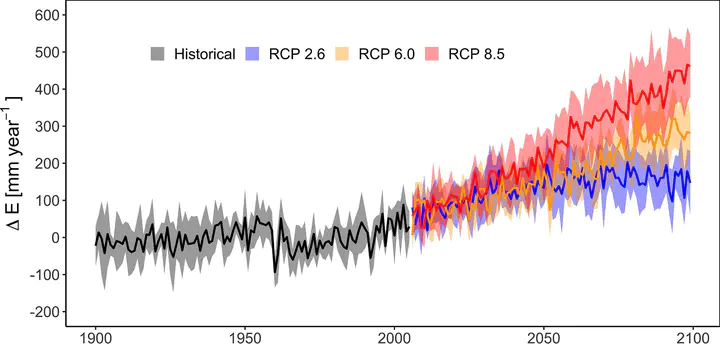 Future projections of evaporation rates for Lake Kinneret, Israel.
Future projections of evaporation rates for Lake Kinneret, Israel.
Abstract
Lake evaporation plays an important role in the water budget of lakes. Predicting lake evaporation responses to climate change is thus of paramount importance for the planning of mitigation and adaption strategies. However, most studies that have simulated climate change impacts on lake evaporation have typically utilised a single mechanistic model. Whilst such studies have merit, projected changes in lake evaporation from any single lake model can be considered uncertain. To better understand evaporation responses to climate change, a multi-model approach (i.e., where a range of projections are considered), is desirable. In this study, we present such multi-model analysis, where five lake models forced by four different climate model projections are used to simulate historic and future change (1901-2099) in lake evaporation. Our investigation, which focuses on sub-tropical Lake Kinneret (Israel), suggested considerable differences in simulated evaporation rates among the models, with the annual average evaporation rates varying between 1232 mm year-1 and 2608 mm year-1 during the historic period (1901-2005). We explored these differences by comparing the models with reference evaporation rates estimated using in-situ data (2000-2005) and a bulk aerodynamic algorithm. We found that the model ensemble generally captured the intra-annual variability in reference evaporation rates, and compared well at seasonal timescales (RMSEc = 0.19, R=0.92). Using the model ensemble, we then projected future change in evaporation rates under three different Representative Concentration Pathway (RCP) scenarios - RCP 2.6, 6.0 and 8.5. Our projections indicated that, by the end of the 21st century (2070-2099), annual average evaporation rates would increase in Lake Kinneret by 9-22% under RCPs 2.6-8.5. When compared with projected regional declines in precipitation, our projections suggested that the water balance of Lake Kinneret could experience a deficit of 14-40% this century. We anticipate this substantial projected deficit combined with a considerable growth in population expected for this region could have considerable negative impacts on water availability and would consequently increase regional water stress.